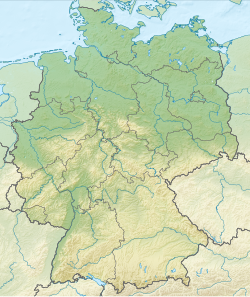Stuttgart Formation
Appearance
| Stuttgart Formation | |
|---|---|
| Stratigraphic range: Carnian ~ | |
| Type | Formation |
| Unit of | Keuper |
| Sub-units | Ansbachersandstein & Schilfsandstein members |
| Underlies | Weser & Steigerwald Formations |
| Overlies | Grabfeld & Benk Formations |
| Lithology | |
| Primary | Sandstone |
| Other | Claystone |
| Location | |
| Coordinates | 49°12′N 9°18′E / 49.2°N 9.3°E |
| Approximate paleocoordinates | 21°24′N 14°54′E / 21.4°N 14.9°E |
| Region | Baden-Württemberg, Bavaria, North Rhine-Westphalia |
| Country | |
| Type section | |
| Named for | Stuttgart |
The Stuttgart Formation is a geologic formation in Germany. It preserves fossils dating back to the Carnian stage of the Triassic period.[1]
Fossil content
[edit]Temnospondyls
[edit]Therapsids
[edit]Reptiles
[edit]Fish
[edit]- Invertebrates[8]
- Aviculomyalina angusta
- Cyzicus laxitextus
- C. cf. dorsorectus
- C. minutus
- Homomya bilonga
- H. simplex
- Myalina rotundata
- Mytilus acutefinitus
- M. avirostrum
- M. hasta
- M. minutus
- M. peregrinus
- M. sulmensis
- Lithophaga buchhornensis
- L. lennachensis
- L. producta
- L. vermiculata
- Mactromya altera
- M. equisetitis
- Modiolus eberstadtensis
- M. formosissimus
- M. mediocarinatus
- M. minalatus
- M. parallelus
- M. parvoblongus
- M. suprarectus
- M. transiens
- M. triangulus
- Myoconcha aperina
- M. longaperina
- M. ovulum
- M. scalprosa
- M. cf. woehrmanni
- M. aff. aquatensis
- Parallelodon beyrichii
- Pinna mediokeuperina
- Pleuromya curta
- P. nitens
- Schafhaeutlia aff. liscaviensis
- Thracia keuperina
- Trigonodus cf. grandis
- T. pygmaeus
- T. singularis
- T. wuertembergicus
- Asmussia sp.
- Gervillia sp.
- ?Gryphaea sp.
- Myoconcha sp.
- Mytilus sp.
- Trigonodus sp.
Flora
[edit]See also
[edit]- List of fossiliferous stratigraphic units in Germany
- List of fossiliferous stratigraphic units in Switzerland
- Benkersandstein, contemporaneous ichnofossiliferous formation of Bavaria
- Chañares Formation, fossiliferous formation of the Ischigualasto-Villa Unión Basin, Argentina
- Candelária Formation, contemporaneous fossiliferous formation of the Paraná Basin, Brazil
- Molteno Formation, contemporaneous fossiliferous formation of Lesotho and South Africa
- Pebbly Arkose Formation, contemporaneous fossiliferous formation of Botswana, Zambia and Zimbabwe
- Denmark Hill Insect Bed, contemporaneous fossiliferous unit of Queensland, Australia
- Madygen Formation, contemporaneous Lagerstätte of Kyrgyzstan
References
[edit]Bibliography
[edit]- Witzmann, F.; Sachs, S.; Nyhuis, C. J. (2016), "A new species of Cyclotosaurus (Stereospondyli, Capitosauria) from the Late Triassic of Bielefeld, NW Germany, and the intrarelationships of the genus", Fossil Record, 19 (2): 83–100, Bibcode:2016FossR..19...83W, doi:10.5194/fr-19-83-2016, retrieved 2020-10-19
- Kustatscher, E.; Kelber, K.-P.; Van Konijnenburg-van Cittert, J. H. A. (2012), "Danaeopsis Heer ex Schimper 1869 and its European Triassic species", Review of Palaeobotany and Palynology, 183: 32–49, Bibcode:2012RPaPa.183...32K, doi:10.1016/j.revpalbo.2012.06.011
- Schoch, R. R (2012), "A dicynodont mandible from the Triassic of Germany forms the first evidence of large herbivores in the Central European Carnian", Neues Jahrbuch für Geologie und Paläontologie - Abhandlungen, 263 (2): 119–123, doi:10.1127/0077-7749/2012/0216
- Sulej, T (2002), "Species discrimination of the Late Triassic temnospondyl amphibian Metoposaurus diagnosticus" (PDF), Acta Palaeontologica Polonica, 47: 535–546, retrieved 2020-10-19
- Schoch, R.; Milner, A. R. (2000), "Stereospondyli", Handbuch der Paläoherpetologie, 3B: 1–203
- Linck, O (1968), "Die marinen Muschelfauna des Schilfsandsteins von Eberstadt, Wuerttemberg, (Trias, Karn, mittl. Keuper 2) und deren Bedeutung", Jahreshefte des Vereins für Vaterlaendsiche Naturkunde in Wuerttemberg, 123: 69–133
- Huene, F. von (1905), "Trias-Dinosaurier Europas - European Triassic dinosaurs", Zeitschrift der Deutschen Geologischen Gesellschaft, 57: 345–349
- Fraas, E (1896), Die Schwäbischen Trias-Saurier nach dem Material der Kgl. Naturalien-Sammlung in Stuttgart zusammengestellt - Swabian Triassic dinosaurs based on the material in the Royal Natural History Collection compiled in Stuttgart, Festgabe des Königlichen Naturalien-Cabinets In Stuttgart zur 42 Versammlung der Deutschen geologischen Gesellschaft in Stuttgart, August 1896. E. Schweizerbartische Verlag-handlung (E. Koch), Stuttgart, pp. 1–18
- Münster, G. G (1839), "Mastodonsaurus andriani", Beiträge zur Petrefactenkunde: 102–103

